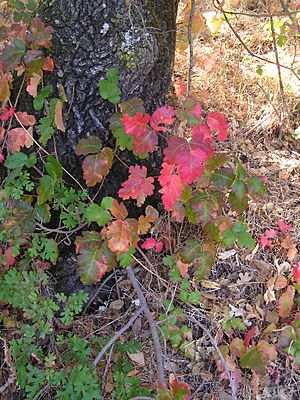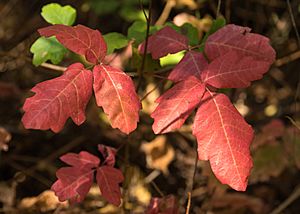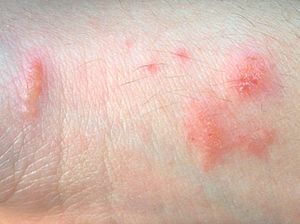Toxicodendron diversilobum facts for kids
Quick facts for kids Toxicodendron diversilobumPacific poison oak |
|
|---|---|
 |
|
| Pacific poison oak (larger leaves) at base of an oak tree | |
| Scientific classification | |
| Genus: |
Toxicodendron
|
| Species: |
diversilobum
|
| Synonyms | |
|
Rhus diversiloba Torr. & A.Gray |
|
Toxicodendron diversilobum, also known as Pacific poison oak or western poison oak, is a plant that grows like a woody vine or a shrub. It belongs to the sumac family, called Anacardiaceae. You can find it across western North America, living in different types of forests, woodlands, grasslands, and chaparral areas.
This plant usually blooms in May. Like other plants in the Toxicodendron group, Pacific poison oak can cause itchy, allergic rashes in many people. This happens if you touch the plant or breathe in its smoke.
Contents
Where Pacific Poison Oak Grows
Pacific poison oak is found in places like California, the Baja California Peninsula, Nevada, Oregon, Washington, and British Columbia. The city of Los Angeles was even built near a village called Yangna, which meant "poison oak place"!
Another similar plant, T. pubescens (eastern poison oak), grows in the Southeastern United States. Pacific poison oak can also mix with T. rydbergii (western poison ivy) in the Columbia River Gorge area, creating new types of plants.
This plant is very common in many different places. It grows well in damp areas near rivers and dry, shrubby lands. It likes both shady spots and direct sunlight. You can find it at elevations below 5,000 feet (1,500 meters).
The vine form of poison oak can climb up large trees, sometimes even harming the trees by covering them or breaking their branches. It often grows in chaparral and woodlands, coastal sage scrub, grasslands, and oak woodlands. It also lives in forests with Douglas-fir, hemlock–Sitka spruce, coast redwood, Ponderosa pine, and mixed evergreen trees.
What Pacific Poison Oak Looks Like
Pacific poison oak can look very different depending on where it grows. It might be a thick shrub, about 1.5 to 13 feet (0.5 to 4 meters) tall, in sunny areas. It can also be a tree-like vine, 10 to 30 feet (3 to 9 meters) long, and sometimes even over 100 feet (30 meters) long with a trunk 3 to 8 inches (8 to 20 cm) wide. In shady spots, it can form dense thickets.

The plant spreads using underground stems called rhizomes and also by seeds. In winter, when it gets cold, the plant loses its leaves. You might still spot it by black marks on the leafless stems, which are dried sap.
The leaves usually have three leaflets, but sometimes they can have 5, 7, or 9. Each leaflet is about 1.5 to 4 inches (3.5 to 10 cm) long. Their edges can be wavy, toothed, or lobed. They often look like the leaves of a real oak tree, but they are usually shinier.
The leaves change color with the seasons:
- Spring (February to March): Bronze color when they first appear.
- Spring: Bright green.
- Summer: Yellow-green to reddish.
- Late Summer to Fall (July to October): Bright red or pink.
White flowers appear in the spring, from March to June. If these flowers are fertilized, they turn into greenish-white or tan berries.
Botanist John Howell once said that even though poison oak is beautiful, its poisonous sap makes people dislike it. He noted its pretty ivory flowers in spring, green leaves in summer, and bright red colors in autumn.
The Plant's Poison: Urushiol
Pacific poison oak leaves and twigs have an oily substance on their surface called urushiol. This oil is what causes an allergic reaction. About four out of five people will get an allergic skin rash, called contact dermatitis, if they touch urushiol. Most people will become more sensitive to it over time if they keep getting exposed.
How Your Skin Reacts
When urushiol touches your skin, it first causes itching. Then, your skin might become inflamed, develop colorless bumps, itch severely, and form blisters. Even in winter, when the plant has no leaves, touching its branches and twigs can still cause an allergic reaction.
Urushiol can also become a gas if the plant is burned. Breathing in smoke from burning poison oak is very dangerous. This can happen during wildfires, controlled burns, or when people try to burn the plant to get rid of it. The smoke can harm people who thought they were immune to the plant. Even using poison oak branches to toast food over a campfire can cause reactions inside and outside your body.
Interestingly, urushiol is also found in the skin of mangoes. So, if you are sensitive to poison oak, you might also react to mangoes if you eat them with the skin on.
How Pacific Poison Oak Fits into Nature
Many animals eat the leaves of Pacific poison oak. These include Black-tailed deer, mule deer, California ground squirrels, and western gray squirrels. The plant is full of important nutrients like phosphorus, calcium, and sulfur. Birds eat the berries and use the plant for shelter. Native animals, horses, livestock, and dogs do not seem to react to urushiol.
Because people are allergic to it, Pacific poison oak is often removed from gardens and public areas. It can also be a weed in farms, orchards, and vineyards. People usually get rid of it by pruning, using herbicides, digging it out, or a mix of these methods.
Uses of Pacific Poison Oak
Traditional Medicinal Uses
Native American tribes in California used parts of the poison oak plant in different ways. They used the stems and shoots to make baskets. The sap was used to treat ringworm and was put on rattlesnake bites. The plant's juice or soot was also used as a black dye for basket parts, tattoos, and to darken skin.
Some native peoples would eat dried roots or spring buds to try and become immune to the plant's poison.
The Chumash people used poison oak sap to remove warts, corns, and calluses. They also used it to stop bleeding and to clean sores. They drank a tea made from the roots to treat dysentery.
Growing the Plant
Pacific poison oak can be a part of wildlife gardens and natural landscaping if placed carefully.
The plant is also used in projects to bring natural habitats back to life. It can be one of the first plants to grow in areas where woodlands have been burned or removed. It acts as a "nurse plant," helping other species grow around it.
Gallery
See also
 In Spanish: Roble venenoso del Pacífico para niños
In Spanish: Roble venenoso del Pacífico para niños








